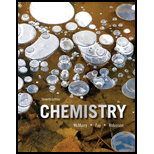
Concept explainers
PROBLEM 16.35 Determine whether
Want to see the full answer?
Check out a sample textbook solution
Chapter 16 Solutions
Chemistry (7th Edition)
- 4. Which of the following solutions is a buffer? (A) 0.10 M CH3COOH and 0.10 MCH3COONa (B) 0.10 M CH3COOH (C) 0.10 M HCI and 0.10M NaCL (D) both A and C (E) all of them: A, B, C. Group of answer choices D C only solution (B) is a buffer only solution (A) is a buffer.arrow_forwardConsider a buffered solution containing CH3NH3Cl and CH3NH2. Which of the following statements concerning this solution is(are) true? (Ka for CH3NH3+ = 2.3 1011.) a. A solution consisting of 0.10 M CH3NH3Cl and 0.10 M CH3NH2 would have a higher buffering capacity than one containing 1.0 M CH3NH3Cl and 1.0 M CH3NH2. b. If [CH3NH2] [CH3NH3+], then the pH is larger than the pKa value. c. Adding more [CH3NH3Cl]to the initial buffer solution will decrease the pH. d. If [CH3NH2] [CH3NH3+],then pH 3.36. e. If [CH3NH2] = [CH3NH3+], then pH = 10.64.arrow_forwardWhat is the equilibrium constant for the following reaction? AgCl(s)+I(aq)AgI(s)+Cl(aq) Does the equilibrium lie predominantly to the left or to the right? Will AgI form if iodide ion. I, is added to a saturated solution of AgCl?arrow_forward
- Blood contains several acid base systems that tend to keep its pH constant at about 7.4. One of the most important buffer systems involves carbonic acid and hydrogen carbonate ion. What must be the ratio of [HCO3] to [H2CO3] in the blood if the pH is 7.40?arrow_forwardA good buffer generally contains relatively equal concentrations of weak acid and conjugate base. If you wanted to buffer a solution at pH = 4.00 or pH = 10.00, how would you decide which weak acidconjugate base or weak baseconjugate acid pair to use? The second characteristic of a good buffer is good buffering capacity. What is the capacity of a buffer? How do the following buffers differ in capacity? How do they differ in pH? 0.01 M acetic acid/0.01 M sodium acetate 0.1 M acetic acid/0.1 M sodium acetate 1.0 M acetic acid/1.0 M sodium acetatearrow_forwardProblem 16.76 - Enhanced - with Feedback Part A Calculate the molar concentration of OH ions in a 0.555 M solution of hypobromite ion (BrO; Kb = Express the molarity to two significant digits. ΥΠΙΑΣΦΑ [OH] = Submit Previous Answers Request Answer * Incorrect; Try Again; 5 attempts remaining Part B What is the pH of this solution? Express the pH to two decimal places. pH = B [VD ΑΣΦ ? M 4.0 × 10 6).arrow_forward
- Item 15 Part A In which of the following aqueous solutions would you expect AgF to have the highest solubility? O 0.015 M KF O 0.00750 M LİF 0.030 MAGNO, O 0.023 M NaF AgF will have the same solubility in all solutions. Submit Request Answerarrow_forward4. a) Data in the following table are obtained for the titration of 0.297g sample of a solid, monoprotic weak acid with a 0.150M NaOH solution. Plot PH vs. V.arrow_forwardWhich salts will be more soluble in an acidic solution than in pure water? O cd(OH), CuCl CSCIO, V BaSO3 SrSO4 Incorrectarrow_forward
- The pK, value for H2 CO3 is 6.38. What mole ratio of KHCO3 to H2 CO3 is needed to prepare a buffer with a pH of 5.99? [HCO3 ] [H2 CO3]arrow_forwardQuestions 11. Water in the Bow River contains a relatively high amount of dissolved limestone, CaCO3. This is an indication that the bedrock of the Bow River O has a high buffering capacity O has a low buffering capacity O accepts a large number of protons from the water O donates a large number of protons to the waterarrow_forwardMatch the solubility of the following compounds. BaCO3 A or B NaCO3 A or B KOH A or B (NH4)2SO4 A or B A. insoluble B. solublearrow_forward
 General Chemistry - Standalone book (MindTap Cour...ChemistryISBN:9781305580343Author:Steven D. Gammon, Ebbing, Darrell Ebbing, Steven D., Darrell; Gammon, Darrell Ebbing; Steven D. Gammon, Darrell D.; Gammon, Ebbing; Steven D. Gammon; DarrellPublisher:Cengage Learning
General Chemistry - Standalone book (MindTap Cour...ChemistryISBN:9781305580343Author:Steven D. Gammon, Ebbing, Darrell Ebbing, Steven D., Darrell; Gammon, Darrell Ebbing; Steven D. Gammon, Darrell D.; Gammon, Ebbing; Steven D. Gammon; DarrellPublisher:Cengage Learning Chemistry & Chemical ReactivityChemistryISBN:9781337399074Author:John C. Kotz, Paul M. Treichel, John Townsend, David TreichelPublisher:Cengage Learning
Chemistry & Chemical ReactivityChemistryISBN:9781337399074Author:John C. Kotz, Paul M. Treichel, John Townsend, David TreichelPublisher:Cengage Learning Chemistry & Chemical ReactivityChemistryISBN:9781133949640Author:John C. Kotz, Paul M. Treichel, John Townsend, David TreichelPublisher:Cengage Learning
Chemistry & Chemical ReactivityChemistryISBN:9781133949640Author:John C. Kotz, Paul M. Treichel, John Townsend, David TreichelPublisher:Cengage Learning Chemical Principles in the LaboratoryChemistryISBN:9781305264434Author:Emil Slowinski, Wayne C. Wolsey, Robert RossiPublisher:Brooks Cole
Chemical Principles in the LaboratoryChemistryISBN:9781305264434Author:Emil Slowinski, Wayne C. Wolsey, Robert RossiPublisher:Brooks Cole Introductory Chemistry: A FoundationChemistryISBN:9781337399425Author:Steven S. Zumdahl, Donald J. DeCostePublisher:Cengage Learning
Introductory Chemistry: A FoundationChemistryISBN:9781337399425Author:Steven S. Zumdahl, Donald J. DeCostePublisher:Cengage Learning





